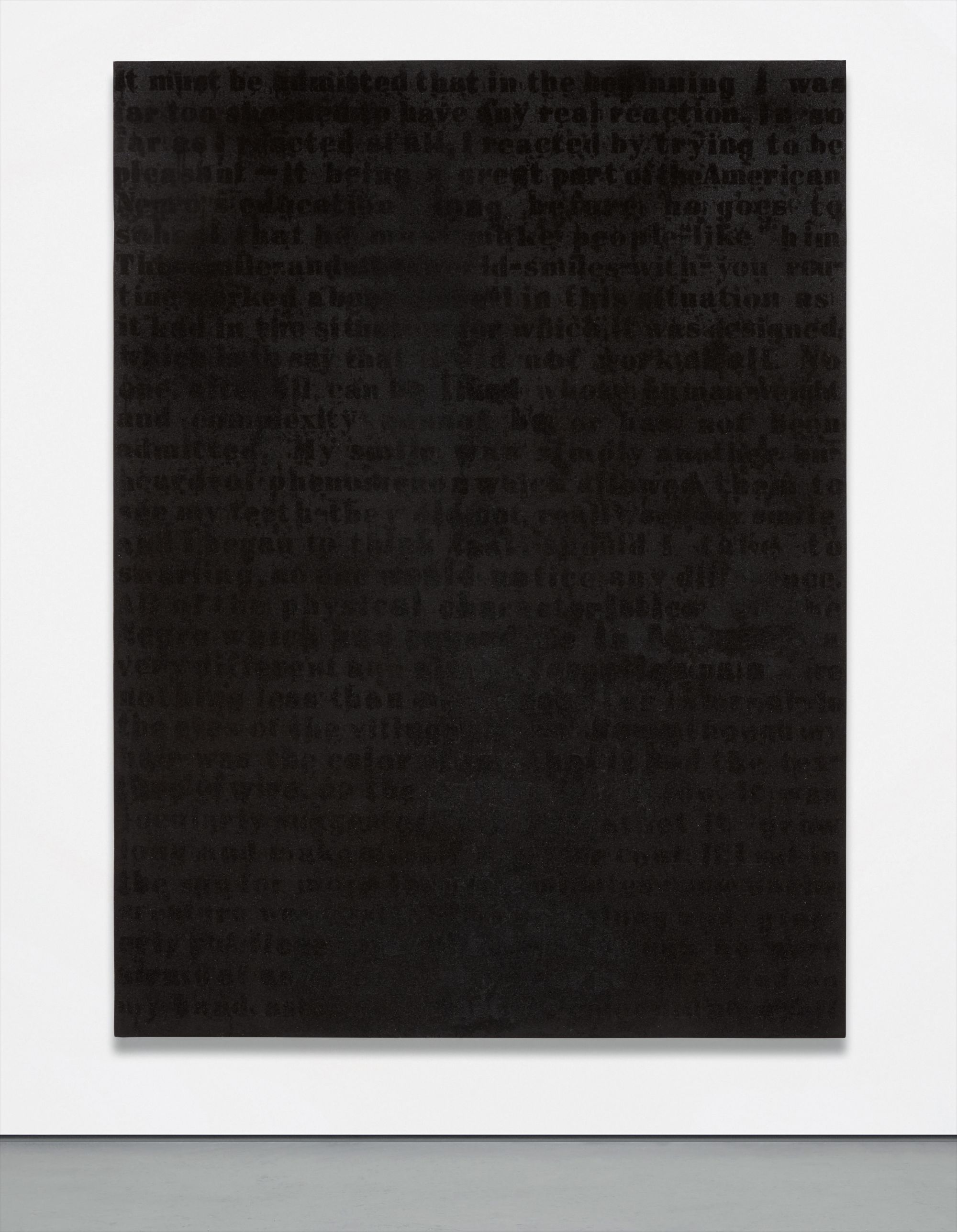

15Δ
Glenn Ligon
Stranger in the Village #11
enamel and coal dust on canvas mounted on panel
96 x 72 in. (243.8 x 182.9 cm)
Signed, titled and dated "Glenn Ligon Stranger in the Village #11 1997" along the overlap.
Full-Cataloguing
“But I also grew up around appropriation and text. Why write your own when there are texts in the world? Appropriating text is a way of getting certain ideas into the work directly.” Glenn Ligon
In 1953, American novelist James Baldwin penned “Stranger in the Village” to articulate his experience as the first black man to visit a remote town in Switzerland. Over thirty years later, the work of artist Glenn Ligon expresses the experience of the contemporary African American in the American landscape. Stranger in the Village #11, executed in 1997, utilizes deep black coal dust and adhesive enamel to stencil a poignant selection from Baldwin’s text. Ligon’s choice of historical prose politicizes his work, and demands an examination of issues of race, legislature and authorship, to an enrapturing result. The opaque lettering and the dichromatic palette obfuscate the words, engaging us to question the surface of the canvas and the capability—or inability—of words to tell truths of racial identity.
Stranger in the Village #11 is immediately illegible, heavy and all-encompassing, inaccessible to our contrast-driven vision. Allowing each word to deteriorate across the horizontal picture plane, Ligon points albeit subtlety to the fact that no matter what elegant string of words may be tied together, it remains utterly impossible to exhaustively describe the human experience. Ligon’s adept use of Appropriations, Conceptualism, and Minimalism enables him to subvert a straightforward categorization. Of his coalescent style, the artist has commented, “The movement of language toward abstraction is a consistent theme in my work. I’m interested in what happens when a text is difficult to read or frustrates legibility—what that says about our ability to think about each other, know each other, process each other.” (Glenn Ligon in Hilarie M. Sheets, “The Writing on The Wall: Glenn Ligon on Borrowing Text to Expose American Racism, in 2011,”ARTNews, January 2016). The present lot utilizes content, form, shape, and language to ignite debates about representation, history and race relationships. Ligon’s use of Baldwin’s text, while seemingly submissive in its obscured presentation, is profoundly resonant in today’s political landscape. Once we parse through the thick layer of dust to grasp the first six lines: “It must be admitted that in the beginning I was far too shocked to have any real reaction. In so far as I reacted at all, I reacted by trying to be pleasant—it being a great part of the American Negro's education (long before he goes to school) that he must make people like him.” (James Baldwin, “STRANGER IN THE VILLAGE,” from Notes of a Native Son, 1955, 1984, pp. 159-75)
In 1953, American novelist James Baldwin penned “Stranger in the Village” to articulate his experience as the first black man to visit a remote town in Switzerland. Over thirty years later, the work of artist Glenn Ligon expresses the experience of the contemporary African American in the American landscape. Stranger in the Village #11, executed in 1997, utilizes deep black coal dust and adhesive enamel to stencil a poignant selection from Baldwin’s text. Ligon’s choice of historical prose politicizes his work, and demands an examination of issues of race, legislature and authorship, to an enrapturing result. The opaque lettering and the dichromatic palette obfuscate the words, engaging us to question the surface of the canvas and the capability—or inability—of words to tell truths of racial identity.
Stranger in the Village #11 is immediately illegible, heavy and all-encompassing, inaccessible to our contrast-driven vision. Allowing each word to deteriorate across the horizontal picture plane, Ligon points albeit subtlety to the fact that no matter what elegant string of words may be tied together, it remains utterly impossible to exhaustively describe the human experience. Ligon’s adept use of Appropriations, Conceptualism, and Minimalism enables him to subvert a straightforward categorization. Of his coalescent style, the artist has commented, “The movement of language toward abstraction is a consistent theme in my work. I’m interested in what happens when a text is difficult to read or frustrates legibility—what that says about our ability to think about each other, know each other, process each other.” (Glenn Ligon in Hilarie M. Sheets, “The Writing on The Wall: Glenn Ligon on Borrowing Text to Expose American Racism, in 2011,”ARTNews, January 2016). The present lot utilizes content, form, shape, and language to ignite debates about representation, history and race relationships. Ligon’s use of Baldwin’s text, while seemingly submissive in its obscured presentation, is profoundly resonant in today’s political landscape. Once we parse through the thick layer of dust to grasp the first six lines: “It must be admitted that in the beginning I was far too shocked to have any real reaction. In so far as I reacted at all, I reacted by trying to be pleasant—it being a great part of the American Negro's education (long before he goes to school) that he must make people like him.” (James Baldwin, “STRANGER IN THE VILLAGE,” from Notes of a Native Son, 1955, 1984, pp. 159-75)